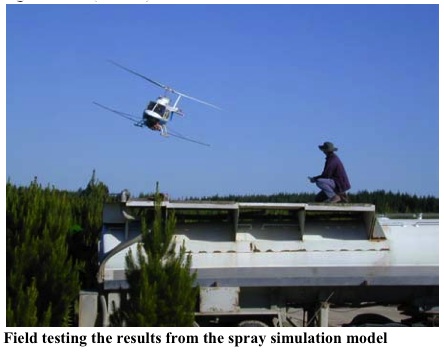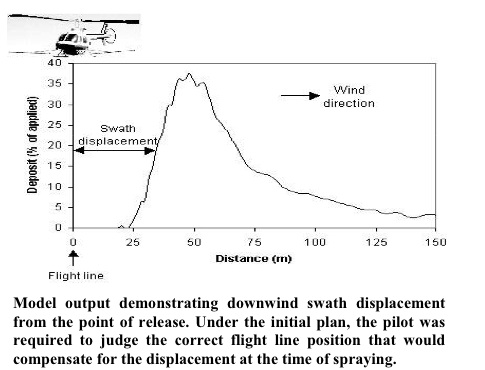PESTS AND DISEASES OF FORESTRY IN NEW ZEALAND
Technology aids painted apple moth eradication programme
Scion is the leading provider of forest-related knowledge in New Zealand
Formerly known as the Forest Research Institute, Scion has been a leader in research relating to forest health for over 50 years. The Rotorua-based Crown Research Institute continues to provide science that will protect all forests from damage caused by insect pests, pathogens and weeds. The information presented below arises from these research activities.
From Forest Health News 116, March 2002.
 Most readers of Forest Health News will know of the current aerial spraying programme being conducted in west Auckland by the Ministry of Agriculture and Forestry (MAF) as part of the eradication campaign against the introduced painted apple moth (Teia anartoides ; FHNews 90:1; 112:1). However, few will be aware of some of the painstaking behind-the-scenes work that has gone into the preparation for this undertaking. As part of this groundwork, scientists at Forest Research were recently asked to provide some important operational advice to MAF based on knowledge and experience acquired during many years of field research in aerial spray methodology. An indispensable tool assisting this preparatory work was a spray simulation model known as “SpraySafe Manager”, developed during the past decade by Forest Research in collaboration with the United States Department of Agriculture (USDA).
Most readers of Forest Health News will know of the current aerial spraying programme being conducted in west Auckland by the Ministry of Agriculture and Forestry (MAF) as part of the eradication campaign against the introduced painted apple moth (Teia anartoides ; FHNews 90:1; 112:1). However, few will be aware of some of the painstaking behind-the-scenes work that has gone into the preparation for this undertaking. As part of this groundwork, scientists at Forest Research were recently asked to provide some important operational advice to MAF based on knowledge and experience acquired during many years of field research in aerial spray methodology. An indispensable tool assisting this preparatory work was a spray simulation model known as “SpraySafe Manager”, developed during the past decade by Forest Research in collaboration with the United States Department of Agriculture (USDA).
The objectives and general specifications for the aerial spray operation were determined by MAF. Their initial plan was to spray Btk insecticide only over the narrow riparian margins between the Whau estuary and adjacent residential areas, where the moth larvae were most concentrated. Although evidence supports the view that Btk is not harmful to people, this approach would limit the extent to which the general population might be exposed to the insecticide.
To determine the best spray application procedures, SpraySafe Manager was used to simulate different scenarios. The software was able to predict the fate of spray droplets when released under varying conditions, and to estimate their horizontal movement from the point of release to the point of deposition on the ground. The magnitude of this displacement was very sensitive to wind speed and even relatively light winds moved the swath significantly downwind. A pilot would be required to judge the correct flight line position necessary to adjust for the estimated swath displacement. This would clearly be a difficult task, especially given variable wind speeds and the convoluted nature of the riparian strips. It was concluded that spraying a narrow strip was impractical using current application methods, and this was one reason why the operation eventually proceeded using larger spray blocks.
 In addition to determining the best aerial application strategy, the model also enabled scientists to address several areas of public concern. These included the time it
In addition to determining the best aerial application strategy, the model also enabled scientists to address several areas of public concern. These included the time it
took for the chemical to dry after deposition on plant surfaces, and the extent to which spray might drift over housing estates beyond the intended target area. Without
the spray model, such questions could be answered only through extensive experiments or by informed guesswork. While aerial spraying of crops or trees is never a simple operation, it is comparatively straightforward when compared to the complexity experienced working in populated areas. A forest is much more uniform than the average suburban landscape, which contains buildings, trees and other structures of varying heights and surface textures. The spray model is designed specifically for operational use in forestry and crop applications, and there are certain characteristics peculiar to the urban environment which are not yet built into this software.
Future research is therefore planned with USDA collaborators to improve spray model capabilities in the urban setting.
Brian Richardson, Forest Research
This information is intended for general interest only. It is not intended to be a substitute for specific specialist advice on any matter and should not be relied on for that purpose. Scion will not be liable for any direct, indirect, incidental, special, consequential or exemplary damages, loss of profits, or any other intangible losses that result from using the information provided on this site.
(Scion is the trading name of the New Zealand Forest Research Institute Limited.)

 Farm Forestry New Zealand
Farm Forestry New Zealand

